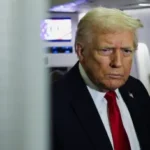
The economic war that promised to strengthen the United States threatens to erode its global prestige and hasten the end of the dollar era
US President Donald Trump’s decision to impose 50% tariffs on products imported from India, in effect since August, may have created an immediate shock to the Indian economy, but it tends to have a much more profound — and lasting — effect on the United States itself. By targeting a crucial strategic partner, increasing inflation and putting pressure on the dollar, Trump risks undermining American economic influence and compromising Indo-Pacific policy, which for two decades has been a key part of Washington’s diplomacy to contain China’s advance.
The reaction in New Delhi was outrage. In addition to the severity of the tariffs, India felt particularly targeted by the 25% surcharge applied as punishment for purchasing Russian oil at a discount — a measure that, according to Trump, represents “indirect financing” of Moscow’s war in Ukraine. The irony is that neither China nor the European Union, equally dependent on Russian energy, have faced similar sanctions.
In the short term, the economic impact on India will be considerable. The United States is today India’s main trading partner, accounting for around 20% of exports and more than 2% of the country’s GDP. Even with specific exceptions — such as the pharmaceutical and electronics sectors — approximately two-thirds of products sent to the USA are now taxed at 50%. Traditional sectors, such as textiles, shrimp, diamonds and auto parts, concentrated in small cities and labor intensive, are among the most vulnerable. The predictable result is the loss of thousands of jobs and the worsening of the difficulties faced by young people seeking employment in the market.
Experts estimate that the impact of tariffs could reduce Indian GDP growth by between 0.3 and 0.8 percentage points. The blow comes at a sensitive time: in recent decades, India has been a rare positive exception in the global economy, sustaining average growth above 6% a year, driven in part by American exports and investment. Commercial and technological ties between the two nations have transformed into a symbiotic relationship. Breaking this gear, analysts warn, would be harmful for both sides.
For the US, the measure could turn into a shot in the foot. The increase in the price of Indian inputs and intermediate goods — from leather to precision engineering — tends to put pressure on production costs and, consequently, consumer prices. The irony is that Trump returned to the White House fueled by popular dissatisfaction with inflation under Joe Biden’s government; however, its tariff policy can generate exactly the opposite effect, eroding its political capital.
The punishment for the purchase of Russian oil is also seen as a strategic error. Discounted Indian oil imports have helped to moderate global oil prices, even benefiting Western economies. Stopping that flow could trigger a jump in prices that neither OPEC nor U.S. shale producers could quickly offset — a shock that would raise energy costs and reignite global inflation.
Trump’s crusade against the trade deficit with India also ignores broader aspects of the economic balance. When investments, royalties, arms sales and educational services are considered, the US wins. Indian students — the largest foreign contingent at American universities — inject billions of dollars a year into the country’s economy. Furthermore, Silicon Valley relies heavily on talent from India, and many multinationals maintain development and technical support centers in Indian cities, reducing costs and increasing profits.
This web of interdependence can quickly unravel. And the damage will not just be economic. India is home to a growing middle class that is expected to surpass 800 million consumers by 2030 — a massive market that American companies risk losing.
In the geopolitical field, India’s isolation poses an even greater threat. Since the early 2000s, both Democrats and Republicans have invested in rapprochement with New Delhi as a way of counterbalancing Chinese power. Cooperation within the Quad group, intelligence sharing and strengthening supply chains were pillars of this strategy. Trump’s tariffs, however, call all of this into question.
At the recent Shanghai Cooperation Organization summit, Prime Minister Narendra Modi met with Vladimir Putin and Xi Jinping, reinforcing India’s “multiple alignment” stance. An eventual rapprochement with China — the opposite of what Washington sought — could redraw the balance of power in the Indo-Pacific. As former US Ambassador to the UN Nikki Haley warned: “To confront China, the United States needs to have an ally in India.”
Meanwhile, the founding BRICS countries — Brazil, Russia, India, China and South Africa — are intensifying efforts to reduce dependence on the dollar and create alternative payment mechanisms in local currencies. Trump’s aggressive policies only accelerate this trend. If they move forward, these plans could erode the United States’ privilege to finance itself cheaply and apply sanctions freely — one of the pillars of American global power.
For India, the challenge is to transform the setback into an opportunity, diversifying markets and strengthening the domestic industry. Reforms can be painful, but the country has shown adaptability and resilience. The United States will face a more complex dilemma: rebuilding trust with a partner that aspires to be an autonomous power in a multipolar world.
In the end, the trade war launched by Trump against India may yield momentary political gains, but it weakens US strategic and economic interests. By distancing itself from one of the fastest growing economies on the planet, encouraging alternatives to the dollar and shaking up essential production chains, Washington risks wasting a vital alliance. India, in turn, may even be injured — but it will probably also emerge more independent, stronger and more influential on the global stage.
Source: https://www.ocafezinho.com/2025/11/09/os-eua-podem-pagar-caro-pela-guerra-comercial-de-trump-contra-a-india/

